L.A. Hybrid Lilies (Lilium longiflorum x Lilium asiatic) for the Farmer Florist
With their star-shaped flowers and pleasant fragrance, lilies add a graceful elegance to any garden. The genus Lilium includes almost 100 species, which primarily grow in Colombia’s mountians and the Aleutian Islands. In Asia, there are 50 to 60 native lily species. North America is home to 24 species, while Europe is home to 12.
Lilies have six tepals, the outer parts of the flower, collectively known as the perianth. The term tepal is used when these parts cannot be easily classified as either sepals or petals. Lily tepals come in many beautiful colors, including pink, gold, red, orange, and white.
Production
Bulb Selection
Lilies are grown from a modified stem structure called a bulb. When selecting bulbs, make sure to purchase from a reputable supplier to avoid any production issues (such as poor flower quality and short stem length) that can occur with low-quality bulbs. A bulb that has a diameter between 16 and 18 centimeters will produce a more vigorously growing plant with more flowers than a smaller bulb.
Thanks to their expansive natural habitat, hybrid lilies can be treated as perennials in USDA Hardiness Zones 3 to 9. In zones that are colder or warmer than this range, lilies are best treated as annuals and replanted every year. Regardless of the zone, lily bulbs should be planted in the fall or early spring, which will provide flowers in mid- to late summer. To have an ample supply of cut lilies for use all summer long, plant bulbs in succession plantings, with 7 to 14 days between plantings.
Cultural Practices
Lily bulbs can grow in a wide range of soil or media types whether in the field or under protection in high tunnels, bulb crates, or containers. Cut lily research suggests they grow best in a well-drained planting medium. While the type of planting media is not critical, its pH is. For adequate nutrient uptake, a slightly acidic pH of 6.0 is optimal for healthy lilies.
Excessive nutrient levels at shoot emergence can be detrimental for lilies grown for cut flower production. If growing lilies in field soil, perform a soil test to determine nutrient reserves. For optimal shoot height, do not fertilize until after shoot emergence, or at the visible bud stage of development if the media has nutrient reserves. At shoot emergence, a fertilizer ratio of 1:1 nitrogen (N) and potassium (K) is beneficial. Slow-release fertilizers can be used. When growing bulbs in bulb crates or containers, a constant liquid fertilization treatment is recommended at the ratio of 1:1 nitrogen and potassium.
Bulbs should be densely planted with an average of 27 to 36 bulbs per square yard. Plant the bulbs 2 inches deep (measured from the top of the bulb) to encourage stem roots to help with stability. After shoot emergence, keep the growing medium moist but not saturated, as root rot problems can be intensified in media with poor aeration. Water stress and wilting can cause bud abortion or abscission.
Insects and Diseases
While a variety of insect pests can feed on lilies, the most serious are aphids and fungus gnats. Due to the damage that aphids can cause on flowers, early detection is critical in preventing damage to flower buds and stems. Yellow sticky traps are one method for early detection of aphids. Placing these traps randomly among plants in the production area and checking them weekly will help catch these pests early on. Another insect that has recently emerged as a serious pest in outdoor production is the lily leaf beetle. This beetle was first discovered in Washington and Oregon in 2012. The beetles are relatively small—about one-fourth inch in size—and a bright, scarlet red. The larvae are voracious eaters and feed nonstop for 3 to 4 weeks before returning to the soil to pupate and continue feeding. To help control the larvae, it is recommended to scout your crop two times per week and scrape off any larvae and eggs into hot, soapy water. There are two organic sprays that have proven effective at controlling the beetle. Weekly treatments using neem oil and spinosad have shown effective control when applied heavily.
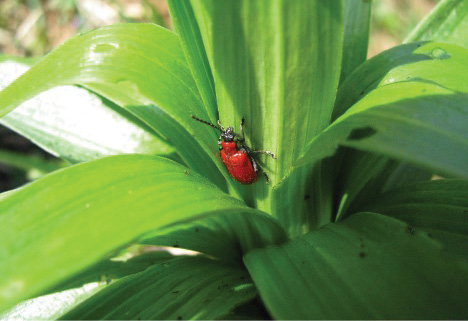
University of Connecticut, Bugwood.org.
Diseases are a major concern in cut lily production. The family of root rots (Fusarium oxysporum, Fusarium, Rhizoctonia solani, Phytopthera cactorum, and Phytopthera parasitica) can be prevented by using a reliable bulb source, pasteurizing the media, and sanitizing the growing area. Additionally, using pre-planting bulb dips and routinely drenching the media with fungicide can help prevent root rot. In addition to root rot, gray mold (Botrytis cinerea) can occur on flowers and leaves if air circulation and humidity control are inadequate. This issue is further compounded during shipping if any flowers are open, because the fungus finds a suitable environment in the sugar-laden nectar at the end of the stigma.
Harvest and Postharvest Handling
Cut stems of lily are usually harvested when buds are well-colored but not yet fully open. Lilies are sensitive to ethylene, so be cautious when storing cut lily stems with other floral material. Growers can use 1-MCP (1-methylcyclopropene), an ethylene inhibitor, safely in any enclosed area including coolers, greenhouses, truck trailers, and shipping boxes.
After harvest, recut the stems and place in floral food solution. Leaf yellowing increases with lengthy storage time, reducing vase life. When selling lilies as potted plants, buds should be well-colored. Plants can be stored and shipped at temperatures between 32°F and 41°F. The shorter the duration of storage, the longer the post-harvest life.
Design Applications
Introduced in 1992, L.A. hybrids are a cross between longiflorum lilies (trumpet-shaped blooms) and Asiatic hybrids (warm colors, upright-facing blooms). L.A. hybrid lilies provide exceptional flowers for floral designs. Classified by some as mass flowers and others as distinctive, we feel they can be used in both categories due to their pattern and form. For this publication, we grew, harvested, and designed the L.A. lily cultivated variety ‘Armandale’, which has spicy, red-orange flowers.
When working with lilies, it is important to remove their anthers just as the flower opens before the pollen becomes dry and easily spread. The first reason to remove anthers is that, when pollen grains attach to the sticky stigma, each grain germinates a pollen tube carrying genetic information through the tube down the style to the flower’s ovary. The pollen tube causes wounding of the style tissue. Wounding from any source increases ethylene synthesis and leads to senescence, or plant tissue death. Lilies are ethylene sensitive, so anther removal eliminates the possibility of pollination.
The second reason to remove anthers is to prevent pollen shedding. As the flower petals and sepals open, anthers begin to mature and expose their pollen. Pollen is lightweight and easily transfers to surfaces.
Pollen can stain fabrics. Do not attempt to dust it off with your fingertips because skin oil and dirt may set the pollen stain deeper into the fabric. Instead, place stained textiles in strong sunlight, such as on a windowsill. After a few days, brush off the dried pollen with a chenille stem or soft brush.
If pollen stains light-colored flower petals, it can be dislodged using a water mister, anti-transpirant spray mist (such as Crowning Glory), or plant hormone mist (such as Hawaiian Floral Mist).
Flowers to Wear
We altered an L.A. hybrid ‘Armandale’ into a tailored boutonniere using one wide and one narrow tepal. Both are wired using the hook method and are surrounded by plumosa fern and ‘Glacier’ ivy leaves. Lilies are often too large to wear, so farmer florists should use the petals and sepals as design elements.
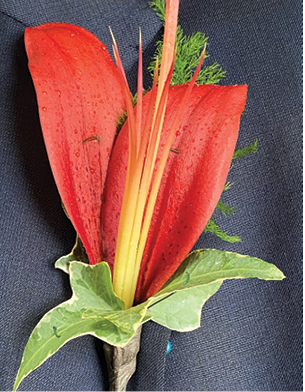
Flowers to Carry
Lily Composite Flower
A florist’s composite is a single flower made from the petals of many flowers. For a version made from gladiolus florets, see MSU Extension Publication 3736 Gladiolus Composite Flower (Glamellia) for the Professional Florist. Begin this project with a roll of #12-gauge aluminum wire, found in wholesale florist supply departments and online. It is soft, malleable, and available in many different colors. We untied the roll and wadded it up into a loose configuration.
Next, form the loose configuration into a handle and platform. To avoid scratching the recipient, tightly curl the ends of the wire and work them into the network of the platform wire.
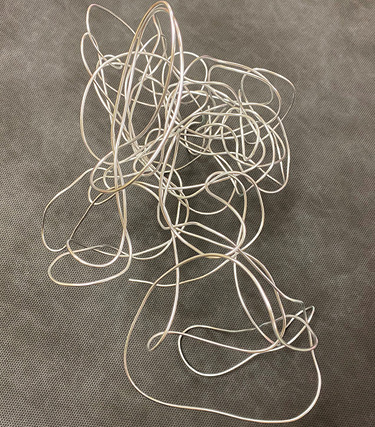
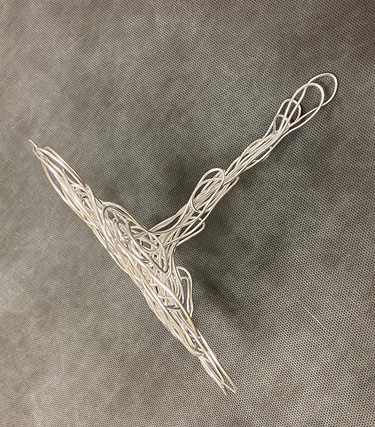
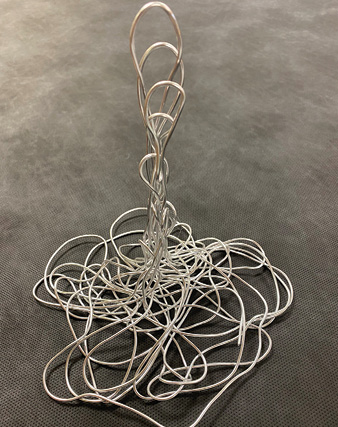
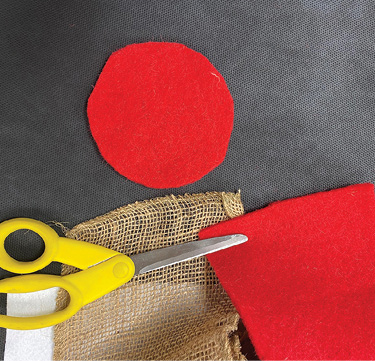
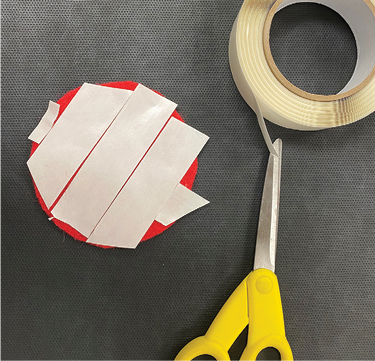
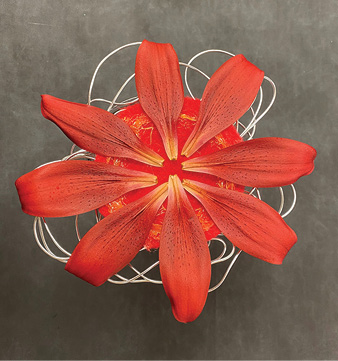
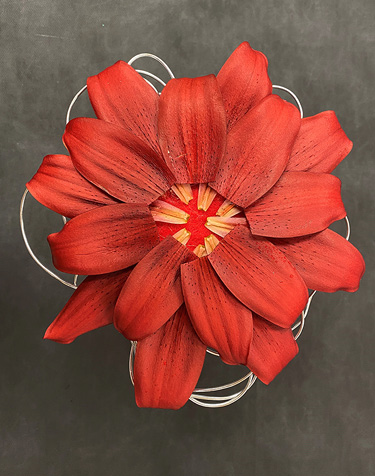
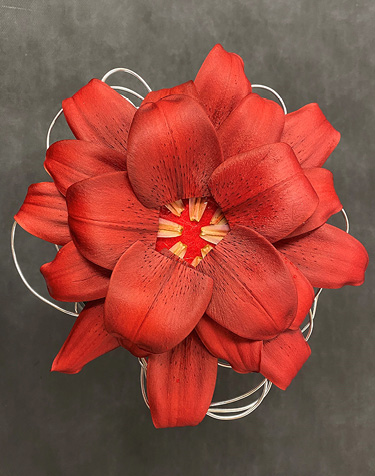
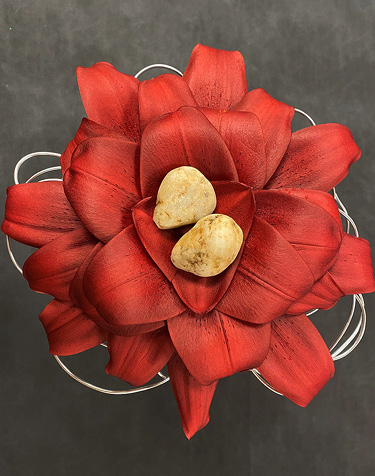
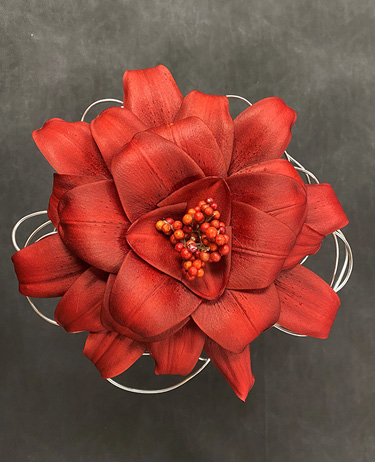
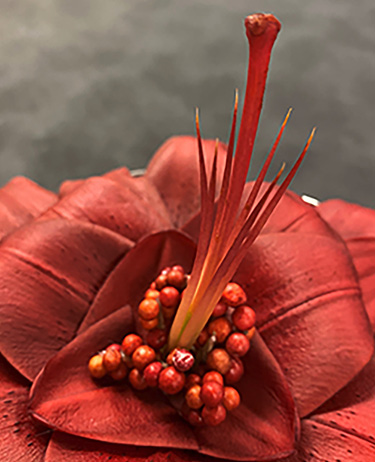
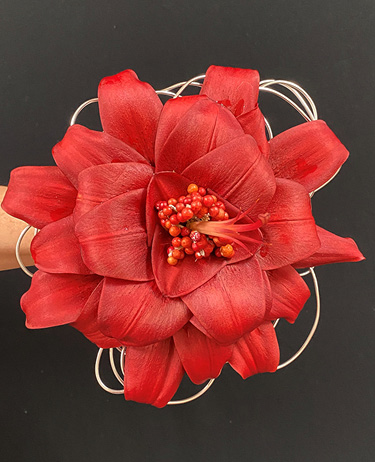
Bridal Bouquet
Here comes the bride! A classic hand-tied arrangement features our rusty red lilies combined with huckleberry foliage (Vaccinium ovatum), bound with waterproof tape (also known as florist pot tape) and wrapped with a light brown, satin ribbon.
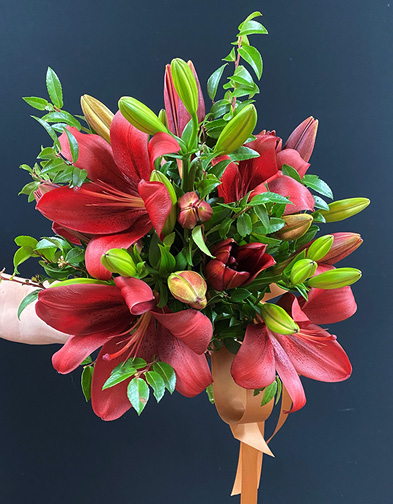
Altar, Buffet, or Table Designs
Lily Garden
We were inspired by the parallel lines of growing lilies and wanted to feature not only their flowers, but their stems and foliage, too. The lilies are arranged in parallel lines and framed by a crescent of corkscrew willow stems. The overall design is reminiscent of a Japanese garden. These versatile arrangements can be displayed singly or in multiple combinations for church altars, side tables, food service tables, or either side of a bride’s or groom’s cake.
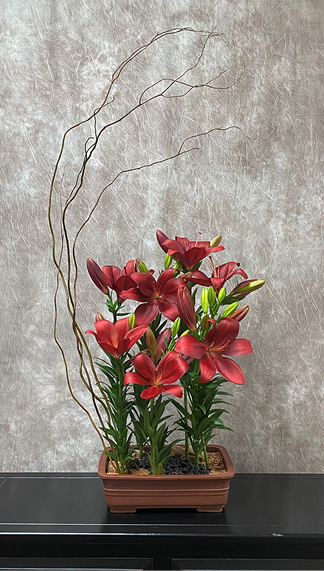
We began with a terra cotta bonsai dish and lined it with vinyl-clad foil. Then, we added fully hydrated, fresh floral foam to the container. Always be sure that containers you select for event floral designs do not leak water. Often, adding an extra layer of protection saves time and effort.
Once we added the plant materials, we covered the foam with a series of basing treatments including sand, rocks, pebbles, and lentil seeds, then misted the surface to help set the elements in place. After a few days, the lentil seeds will sprout into a small, leafy garden.

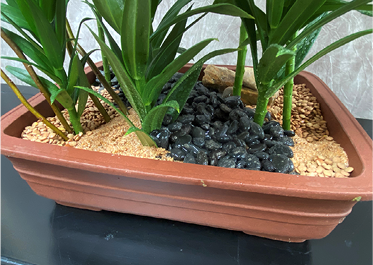
Lily Topiary
A very simple design concept, our lily “topiary” features just two stems of ‘Armandale’ L.A. hybrid lilies. A pair of these arrangements would be elegant on a fireplace mantel or framing a groom’s cake. Create them in three different sizes/heights, and group the trio for an impactful accent that is quick to create!
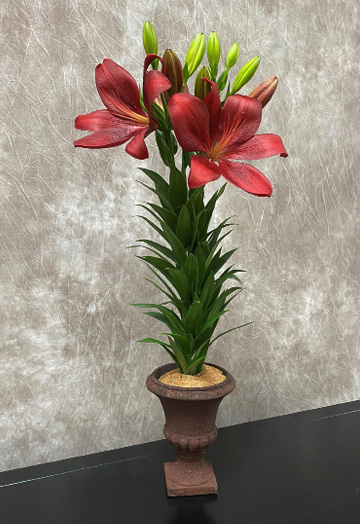
Lily’s sepal looks like a petal, but is part of the outer ring
Stamen (male) forms part of a circle around the carpel
Carpel (female) is in the center of the flower
Anther produces pollen
Filament supports anther
Ovary is where seeds are produced
Petal attracts animals, such as insects, for pollination
Stigma receives pollen
Style connects ovary and stigma
Carpel (female parts) consists of ovary, style, and stigma
Stamens (male parts) each consist of filament and anther
References
Dole, J., & Wilkins, H. 2005. Floriculture: Principles and species (2nd ed.). Pearson.
Hunter, N. 2013. The art of floral design (3rd ed.). Delmar.
Jones, M. 2014. Protecting plants from ethylene damage using 1-MCP.
Johnson, J., McKinley, W., & Benz, B. 2001. Flowers: Creative design. San Jacinto.
Longfield Gardens. How to control red lily leaf beetles.
McKinley, W., Cravens, L., DelPrince, J., Scace, P., Gallagher, J., Jaras, J., & McGukin, S. 2022. The AIFD guide to floral design (3rd ed.). Schiffer.
Scace, P.D. & DelPrince, J. 2020. Principles of floral design (2nd ed.). Goodheart-Willcox.
United States Department of Agriculture. USDA Plant Hardiness Zone Map.
Publication 3818 (POD-10-22)
By Anthony T. Bowden, Research Associate, South Mississippi Branch Experiment Station; James M. DelPrince, PhD, AIFD, PFCI, Associate Extension Professor, Coastal Research and Extension Center; Patricia Knight, PhD, Research Professor and Director of Coastal Horticulture Research; and Christine Coker, PhD, Research Professor, Coastal Research and Extension Center.
The Mississippi State University Extension Service is working to ensure all web content is accessible to all users. If you need assistance accessing any of our content, please email the webteam or call 662-325-2262.

